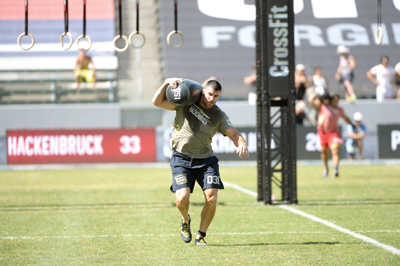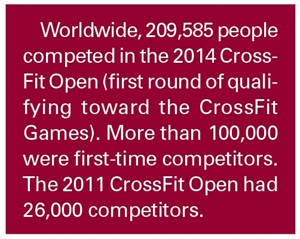We watched with interest recently as the Reebok CrossFit Games were televised on ESPN. Like most sports industry practitioners, we’d heard about this event and probably thought it was a nice way for young people to show off their muscles. Was this a fad that would pop up, catch a bit of attention and then just fade away?
In chatting about it, we thought this was likely another participatory rage to put up on the shelf with karate in the ’70s, racquetball in the ’80s, yoga in the ’90s, and Pilates, P90X and Zumba aerobics more recently. Somewhere, we thought, a minor celebrity was lying on a beach, pocketing a mint after inventing the latest way to fight obesity and flabbiness.
But after seeing CrossFit live (and checking out its website and chatting with a few friends, students and colleagues who participate), our views changed substantially, if not completely. Like the Tough Mudder, Warrior Dash, Spartan Race and Ironman events of the world (all of which have taken their share of the sport-participation pie), CrossFit looks poised to follow in notable tracks and perhaps go beyond.
Looking for an unlikely game-changing industry example? How about the Ultimate Fighting Championship? That’s what CrossFit may be. In the same way UFC and mixed martial arts allow participants from any fighting background to participate (but also expand their fighting techniques), the CrossFit Games test athletes who don’t always know their specific events until just before they compete and they draw from a variety of workout disciplines that incorporate wide ranging fitness exercises and expertise.
So imagine not only needing to be able to do 125 pull-ups, but also swimming, running, climbing, jumping, any Olympic-style lifting and more. It’s truly a test of all-around fitness with a strong dose of strategy thrown in. Anyone who watches, who has any kind of athletic background, is likely to observe at least one discipline in which they could shine.
“CrossFit works because it tests the 10 general physical skills. It doesn’t strive to be great at just one particular skill; it wants everyone to be good at everything,” said Lance Weber, a trainer at CrossFit Billings in Montana. “It’s a sport that can test the elite athletes of all sports and fitness competitions alike, as well as be 100 percent scalable for older generations as well as any athlete in
 |
|
Participants compete in team and solo events at the CrossFit Games last month at the StubHub Center in Carson, Calif.
Photos by: CrossFit Inc. (2)
|
between.”
So why is CrossFit a hot topic? Well, one reason may be the movement away from NCAA-style regulations and the disengagement of “regular” athletes. Another could be the culture.
“The camaraderie in CrossFit is amazing,” said Weber, whose facility is owned by Kerry and Yurii Hanson of Billings. “It’s the one place where you will see the winners turning back to cheer on their competition. To be honest, the people in last place are getting the loudest cheers and applause, whether it’s in the gym or at the games.”
That’s much, we imagine, like watching the final finishers of the Ironman crossing the finish line before midnight. It’s in those settings that the “every finisher is a winner” motto shows its value.
“I played baseball in high school, dreaming of going to the pros,” Weber said. “But competing at a level of such high caliber wasn’t in the cards for me. I came across CrossFit in college and found a new sport that was more challenging than I could imagine. People from all over the world were getting the opportunity to become elite competitive athletes or else really reaching lifetime fitness goals. Either way, you’ve got to admit, that beats sweating on a treadmill for hours.”
Heather Lawrence, a professor of sport management at Ohio University and a CrossFit Level 1 trainer, said there seems to be some misunderstanding about CrossFit. “[It] often gets viewed as an elite club of superior athletes pushing themselves to the brink of exhaustion during every workout,” Lawrence said. “In reality, coaches modify workouts for each individual to ensure the workout is high intensity but meets the individual’s needs. So it’s not uncommon for CrossFit classes to include a teenage girl living with cystic fibrosis, a stay-at-home mother, former college student athletes, weekend warriors, and a few high-level athletes all completing the workout together with modifications as needed. The result is a welcoming community of people bonding through the shared experience of pushing their physical and mental limits.”
 |
As people of all ages in developed countries battle the inactivity crisis in a world with numerous attractive inactive pursuits from spectatorship to video games on iPads, properties that are cool and sexy may just be the secret to helping stem health consequences and spiraling health care costs. And although we often talk about youth stagnation, we know adults need fun active programming as well. CrossFit’s growth trajectory may suggest older folks are figuring that out.
That ESPN carried the 2014 Reebok CrossFit Games last month on all of its platforms (ESPN, ESPN2, WatchESPN and primarily ESPN3) and Reebok is leveraging a 10-year partnership with CrossFit (including naming rights) should count for something. Reebok and ESPN3 may seem like lesser lights to some industry veterans but give CrossFit credit for cementing these deals.
As for us, while we’re still not 100 percent sure about this latest fitness movement, we are certain CrossFit, Tough Mudder and the UFC should show up on the radars of industry practitioners. In the case of participation sports, get a handle on what makes something fun, sexy and cool (at the same time). For those with many constituent institutions (think the NCAA), give your “body” a chance to let more student athletes shine, particularly female athletes.
Rick Burton (rhburton@syr.edu) is the David B. Falk Professor of Sport Management at Syracuse University. Norm O’Reilly (oreillyn@ohio.edu) is professor and chair of the Department of Sports Administration at Ohio University.







